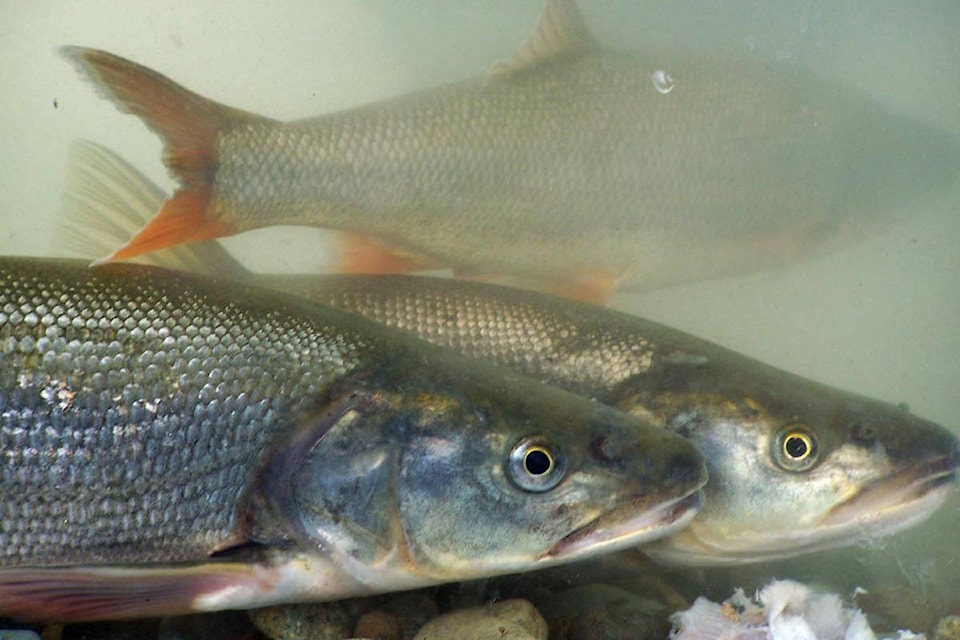There’s a growing concern from anglers that there may be another species contributing to the decline of the kokanee salmon in Kootenay Lake.
The presence of northern pikeminnow is becoming more and more prevalent, particularly in the West Arm, and some anglers believe they are making an impact on the kokanee.
Balfour resident Chuck Wood has been fishing the lake for 36 years, and has never seen more of the predator than he has this year.
“The last two times I fly fished the arm there were huge schools of them coming up,” said Wood. “I caught 10 the first evening and nine the second and released one rainbow. I’m hoping to see the return of decent sized fish in the lake but so far the decision-makers haven’t had any success.”
The BC Ministry of Forests, Lands, Natural Resource Operations and Rural Development could not provide a biologist for an interview due to the ‘interregnum’ (upcoming provinical election), but did offer some data.
According to FLNRO, “We have looked at pikeminnow diet in the west arm, and kokanee were not observed. Studies from other lakes show some kokanee in diet, but data from Kootenay Lake suggests strongly that bull trout and rainbow trout make up the majority of kokanee mortality via predation.”
Kootenay Lake advocates and the BC Wildlife Federation kicked off an ‘Angler Incentive Program’ in June, which encourages anglers to keep an increased limit of bull trout and Gerrard rainbow trout in an attempt to restore the once thriving kokanee population.
Gerrard rainbows and bull trout were responsible for reducing the kokanee population from a return of about 1.5 million in 2011 to less than 20,000 fish in 2015.
As a result, the large Gerrard rainbow and bull trout also died off, dropping angler hours from more than 40,000 annually to less than 12,000.
What remain are smaller rainbow and bull trout, that feed on the kokanee fry and inhibit population growth.
The Angler Incentive Program is an effort to get anglers and kokanee back by introducing increased limits on predator trout, and offering draws every month that support local businesses. For every trout head brought into one of four depots, anglers are put into a draw to win a $1,000 gift certificate and also eligible for the grand prize draw of a Kingfisher boat with a value of over $50,000.
Yet, anglers, like Wood, wonder if the northern pikeminnow should also be on that list of predatory fish.
“Over the years the pikeminnow population has grown tremendously,” said Wood. “There used to be a lot of rainbow rising in the west arm, now there are schools of young pikeminnows.”
Another West Arm angler, reported, “The amount of coarse fish in the Arm is incredible. So many peamouth chub as well. Huge schools.”
At Cultus Lake on the Lower Mainland, the local Lions Club runs a pikeminnow derby over Father’s Day weekend and harvest hundreds of pikeminnow. Northern pikeminnow are the main predator of the juvenile Cultus Lake sockeye – a unique population of salmon that spawn exclusively in the lake.
South of the border, Washington State has run the most intensive and longest pikeminnow-culling program on the Columbia River. For the last 30 years, the Northern Pikeminnow Sport-Reward Fishery runs from May 11 to Sept. 30 from the Priest Rapids Dam to Columbia’s mouth, near Astoria, Oregon. Anglers are normally paid between $5 and $8 for each fish caught, however, last month the reward-fishery extended the season to Oct. 11 and boosted the bounty to $10 per fish.
In addition, all tagged pikeminnow – normally worth $500 each – are now worth $1,000 per fish.
“Catch rates have been fairly average so far this year, but we are now at the time of year when catches are historically the highest of the season,” said Eric Winther, project leader with Washington Department of Fish and Wildlife (WDFW).
“Unfortunately, there have been fewer people taking part in this unique opportunity in 2020. Northern pikeminnow are the primary fish predator on juvenile salmon and steelhead in the Columbia and Snake River systems, and managing those populations is a key element of predator management in the basin. So it’s great that we can offer these increased rewards and a longer season when fishing is very good.”
So, if pikeminnow feast on juvenile salmon and steelhead (anadromous rainbow trout), what is stopping the Kootenay Lake species from feasting on kokanee?
“Northern pikeminnows have an impact on the fry, and what can be done about it?” asked Wood. “I have trolled the lake a lot, there are areas where the bottom is covered in fish that I assume are pikeminnows.
“What do they eat when they’re feeding? I’m sure it’s other fish. You can catch them on a hair jig when they are feeding in the outlet which means they are after minnows.”
Despite anglers’ observations, FLNRO does not yet see the northern pikeminnow as the same threat to kokanee as they are to salmon and steelhead stocks in the lower Columbia River.
“We have been encouraging anglers to harvest pikeminnow, but do not forecast a benefit to including these in the Incentive program,” the ministry spokesperson replied.
According to WDFW, in this slow COVID year, anglers have caught about 97,000 pikeminnow in the Columbia River.
In 2019, the top 20 anglers caught an average of 3,041 pikeminnow per angler and averaged reward payments of $25,367 each for the five-month season. The highest-paid angler in 2019 caught 6,482 fish and earned $53,107.
Over 5.1 million northern pikeminnow have been removed to date by anglers participating in the Sport-Reward Fishery, resulting in a decrease of predation on juvenile salmonids of up to 40 percent from pre-program levels.
The Northern Pikeminnow Sport-Reward Fishery is funded by the Bonneville Power Administration.
